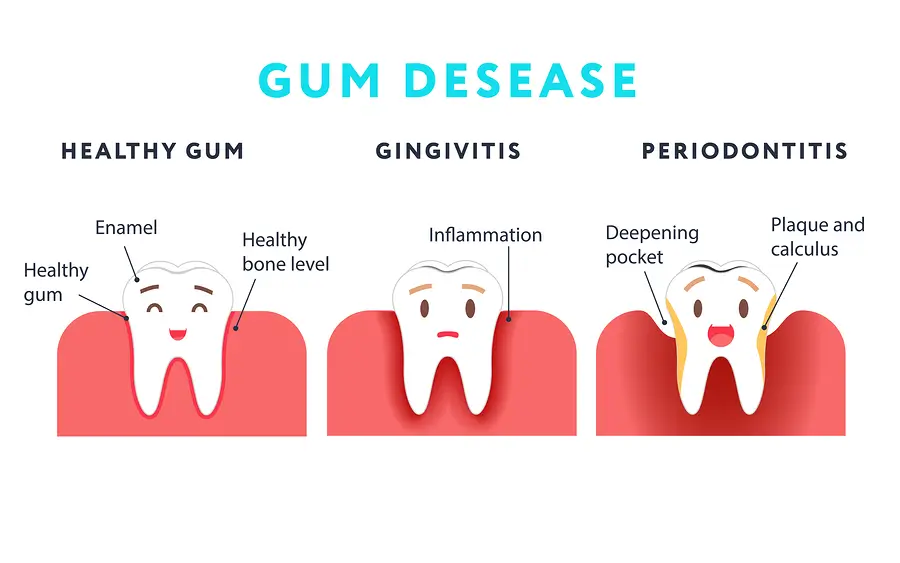Gum Diseases: Causes, Symptoms, and Treatments
Introduction
Gum diseases are among the most common oral health problems that can significantly affect overall well-being. Healthy gums serve as the first line of defense against infections and help support and protect the teeth. With factors such as poor dietary habits, smoking, and inadequate oral hygiene on the rise, it is crucial to understand the causes, symptoms, and treatment options for gum diseases. This article provides an in-depth overview, enabling readers to recognize the underlying causes, early warning signs, and the latest preventive and treatment methods.

Causes of Gum Diseases
1. Plaque and Bacterial Deposits
The primary cause of gum inflammation is the accumulation of dental plaque and bacterial deposits. When plaque is not removed regularly through brushing and flossing, bacteria proliferate and produce toxins that lead to inflammation and damage to the gum tissues.
2. Genetic Factors
Genetics also play a significant role in determining an individual’s susceptibility to gum disease. Some people may have a hereditary predisposition that affects their immune response to bacterial infections in the gums.
3. Lifestyle and Nutrition
A diet high in sugars and starches contributes to plaque formation. Insufficient intake of essential vitamins and minerals, such as vitamin C, can weaken the gum tissue’s resilience and exacerbate inflammation.
4. Smoking
Smoking is one of the most critical risk factors in the deterioration of gum health. It weakens the immune system, making it harder for the body to fight off infections, thereby increasing the likelihood of developing chronic gum disease.
5. Hormonal Changes
Hormonal fluctuations during puberty, menstruation, pregnancy, or menopause can make gums more sensitive and susceptible to inflammation. These changes often heighten the body’s response to the bacteria in plaque.
Common Symptoms of Gum Diseases
1. Red and Swollen Gums
Redness and swelling of the gums are the first noticeable signs of gum disease. The inflammation typically begins along the gum line and may spread as the condition worsens.
2. Bleeding Gums
Gum bleeding during brushing or flossing is a critical indicator of gum inflammation. It signals that the gums are under attack by bacteria and may need immediate attention.
3. Bad Breath
Persistent bad breath is often caused by the bacteria present in plaque, which release foul-smelling compounds. This symptom tends to worsen as gum disease progresses.
4. Receding Gums
As the disease advances, the gums may recede from the teeth, creating gaps that not only look unsightly but also provide spaces for further plaque accumulation.
5. Tooth Sensitivity
Increased sensitivity to hot or cold foods and beverages may occur due to the thinning of the gum tissue and exposure of the tooth roots.
Diagnostic Methods
1. Clinical Examination
Dentists perform a thorough clinical examination of the mouth, checking for signs of inflammation, swelling, and bleeding. Specialized tools are used to measure the depth of the gum pockets, which helps in assessing the severity of the disease.
2. Radiographic Imaging
X-rays and other imaging techniques are used to evaluate bone loss around the teeth, an important indicator of advanced gum disease.
3. Laboratory Tests
In certain cases, blood tests may be recommended to check for systemic conditions or immune disorders that could contribute to gum disease.
Treatment Options
1. Non-Surgical Treatments
Deep Cleaning (Scaling and Root Planing)
Deep cleaning is often the first step in treating gum disease. This procedure involves the removal of plaque and tartar from both the tooth surfaces and the areas beneath the gums. Special instruments and techniques ensure that even the hardest-to-reach areas are thoroughly cleaned.
Antibiotic Therapy
For moderate to severe infections, dentists may prescribe local or systemic antibiotics to help eliminate the harmful bacteria causing the inflammation.
2. Surgical Treatments
Gum Surgery
In advanced cases, surgical intervention might be necessary to restore healthy gum tissue. Procedures may include flap surgery, which involves lifting back the gums to remove tartar, and regenerative procedures to rebuild lost bone and tissue.
Laser Therapy
healing Modern laser treatments offer a minimally invasive option for treating gum disease. Lasers can precisely remove infected tissue and bacteria, reduce inflammation, and speed up the healing process with minimal discomfort.
3. Complementary and Home Remedies
Antiseptic Mouth Rinses
Using antiseptic mouth rinses that contain chlorhexidine can help reduce bacterial load in the mouth and support the healing process.
Daily Oral Hygiene
Maintaining a rigorous oral hygiene routine—including brushing twice daily with a soft-bristled toothbrush, flossing, and using an appropriate mouthwash—is vital for preventing the progression of gum disease.
Prevention and Maintenance
1. Personal Oral Care
Adopting good daily oral hygiene habits is critical. Regular brushing, flossing, and the use of antibacterial mouth rinses can prevent plaque buildup and reduce the risk of gum disease.
2. Regular Dental Visits
Routine check-ups allow for early detection and management of any gum-related issues. Professional cleanings every six months are highly recommended.
3. Healthy Diet
A balanced diet rich in essential nutrients supports overall gum health. Limiting sugary and starchy foods can significantly reduce plaque formation.
4. Smoking Cessation
Quitting smoking is one of the most effective ways to improve gum health and lower the risk of gum disease. Smoking cessation programs and support groups can be beneficial.
Importance of Awareness and Education
Educating patients on the importance of gum health is crucial. Awareness campaigns and educational workshops help spread accurate information and encourage preventive practices, thereby reducing the prevalence and severity of gum diseases.
Conclusion
Gum diseases are not just an aesthetic issue—they are a serious health concern that can impact overall quality of life. By understanding the causes, recognizing early symptoms, and implementing effective treatment and preventive measures, individuals can protect their oral health and, in turn, their general health. Consistent oral hygiene practices and regular dental visits are key to maintaining healthy gums. Through increased awareness and education, patients can take proactive steps to prevent the onset of gum disease and ensure a healthy, confident smile.
